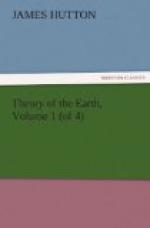In the theory now given, the earth has been represented as a composition of different materials, which had existed in another form, and as the effect of natural operations; therefore, however various may be found the structure of our earth, and however dissimilar some parts of its composition may be in comparison with others, no part should be considered as original, in relation to the globe, or as primitive, in relation to second causes, i.e. physical operations by which those parts should have been formed. But it is pretended by naturalists, that there are certain primitive mountains in the earth, bodies which have had another origin than that of the general strata of the globe and subsequent masses; an origin, therefore, which cannot be considered as having been produced from natural operations, or as effected in the course of known causes. Now, if it can be made to appear, that there is no solid ground for this distinction; and if it can be shown, that there is truly no mineral body in this earth which may not have been produced by operations natural to the globe, we should thus procure a certain confirmation of the doctrine. This also will be the more interesting, in being deduced from a part of natural appearances, which seemed to be inconsistent with the theory.
Certain masses or mountains of granite, are the only bodies of this earth which have apparently a certain pretension to this species of originality. These, therefore, must be now the subject of our examination.
Granite, considered by itself, does not appear to have any claim to originality in its nature. It is composed of bodies which are capable of being analyzed; and these are then found to be compositions of different substances, which are also sometimes variously proportioned. The feldspar and the mica, for example, as well as the schorl, are found variously coloured in different granites, and coloured in various proportions. Besides the variety in the composition, or chemical mixture of the different bodies which compose granite, this rock admits of a great diversity, from the variety of its mechanical mixture, or from the different species of bodies which are its constituent parts. M. de Saussure, who has examined this subject perhaps more than any other person, and who has had the very best opportunities for this purpose, says, that this composition may be found in all the different combinations which may be produced by every possible composition of 7 or 8 different kinds of stone, (page 108, Voyage dans les Alpes, etc.). Neither does this fill up the measure of its variety; for, another source of change is found in the grain of this rock stone; I have a specimen of this variety from the size almost of sand to that of some inches.
Were granite, therefore, to be supposed as in the original state of its creation, nature would be considered as having operated in an indefinite diversity of ways, without that order and wisdom which we find in all her works; for here would be change without a principle, and variety without a purpose. There is no reason, however, to suppose granite original, more than any other composite rock, although we may be ignorant of the particular process in which it is formed, and although, comparatively in relation to certain other rocks, granite, or certain masses of this composition, may be found of a more ancient date.




